This sample World Development in Historical Perspective Research Paper is published for educational and informational purposes only. Like other free research paper examples, it is not a custom research paper. If you need help writing your assignment, please use our custom writing services and buy a paper on any of the economics research paper topics.
Since the end of World War II, the world economy has been transformed from a devastated and fragmented assortment of national economies primarily engaged in producing a low level of basic commodities for local consumption into a unified set of product, factor, and financial markets of global dimensions generating a tremendous volume and variety of goods and services supporting a much higher level of living for the world’s population. The combination of high population growth, a brisk pace in capital formation, ever widening markets, and accelerating technological advances led to a rapid rise in production with corresponding large-scale changes in productive structures and patterns of international trade. More than a half century after this transformation began, in the early years of a new millennium, the world economic landscape is markedly different from the scene of destruction, war weariness, and backwardness presented at the end of World War II, with a fully integrated group of prosperous, economically advanced countries tied closely to a group of developing countries rapidly modernizing their economies and, at a distance, mutually bound to a less integrated set of poorer and lagging countries divided by circumstance, culture, polity, and policy.
This research paper reviews the changes that have taken place in the world economy during the second half of the twentieth century into the first decade of the twenty-first. It begins with a brief review of changes in the arrangements supporting world development during this period and the advances that have been made in lifting world incomes and improving levels of living of the world’s population. It then focuses on the pace, pattern, and stability of world economic growth from 1950 to the present and notes that it slowed over time and became increasingly marked by disparities and instabilities.
The discussion focuses on four characteristics of contemporary world development: the strong recovery in world production from the setbacks of two worldwide wars and the deep depression of the first half of the twentieth century, the rapid increase in international trade in the postwar period despite the widening imbalances and increased instability that now describe the international economy, the rapid initial pace of world growth followed by a marked slowdown in the expansion of world economic activity, and the marked differences in levels of living and growing disparity in individual country growth rates between higher income and lower income areas that describe recent decades. The research paper concludes by noting some challenges before the world economy in a new century.
Changes in the World Economic and Political Landscape
The dimensions of the economic progress mankind has made since 1950 are reflected in the enormous gains recorded in population, production, and productivity across the entire globe. The Earth can now support a much higher population at a much higher level of living than any previous epoch in human history. Its habitable area has been extended greatly, and huge new areas have been opened to the cultivation of food and the extraction of raw materials. The exploration of the moon, planets, and stars has begun, and in an answer to dreams from time immemorial, man walked on this planet’s nearest celestial neighbor. The study of space and the contribution it can make to improving human welfare has begun in earnest and promises great benefits to mankind. The deep oceans now contribute greatly to meeting humans’ everyday needs. Most important, there is not one area of the world that has not gained from the progress humankind has made during this extraordinary period of world history.
These advances were supported by accumulating knowledge about the world, a much more skilled and educated population, and an accelerating pace of technological change shared across borders and encouraged by a strong upsurge in world trade and foreign investment. As the momentum of world commerce increased and outpaced the rise in domestic output and incomes, the production of sophisticated manufactured products has spread from the old industrial centers of Europe and North America to emerging countries where the latest techniques are now being integrated into the economies of previously low-productivity primary-producing countries. Reflecting much higher average incomes, structures of production and patterns of expenditures everywhere are markedly different today than in the past. The geographic distribution of humankind has also changed radically as people have become more mobile nationally and internationally, and human settlements have become increasingly concentrated in high-income urban areas connected by extensive transportation and communication links that tie the world together.
In terms of demographic characteristics, economic circumstances, and social development, the world today reflect tremendous improvements over the situation prevailing in the decades and centuries prior to the mid-twentieth century, especially the troubled period leading up to unprecedented global expansion that has taken place since the end of World War II. This progress reflects not only an increased knowledge about the world but a restructuring of the global economic and political order that promoted international commerce and encouraged better economic management at the national level in the context of a set of generally accepted rules, regulations, and procedures applied to an increasing number of the world’s countries.
Renewal of Economic Advance and the Rebuilding of the International Order
The years following 1950 witnessed a strong renewal of global progress from a protracted and deep worldwide depression and the aftermath of a devastating full-scale war extending across several continents. In the decades following the Great Depression and World War II, despite extraordinary political tensions and the potential for nuclear devastation, many areas of the world entered a prolonged period of peace and prosperity as the global economic and political order was adapted to new realities. Although incomplete, and with many setbacks and glaring disparities among countries, in historical perspective, the progress made the past half century is extraordinary in terms of problems overcome and wealth generated across the world.
In the economic area, real gross world product per capita increased more than threefold from 1950 to 2008 as labor productivity rose rapidly in response to a broadening division of labor, more capital per worker, and innovations in organization, products, techniques, and transport. High and balanced growth in the more economically developed areas was restored to these countries that compares favorably with any previous period in their history. Rapid and sustained growth emerged in many developing countries, spurred by closer international economic integration among all countries. In many regions of the world, a growing convergence of material well-being at an unprecedented high level describes the changes taking place. The rise in output brought with it not only widespread improvements in material levels of living and a better quality of life for people on every continent but also significant improvements to demographic characteristics and great strides in political and social development across the globe. The extent of economic progress was unprecedented in the history of mankind, both in terms of the pace of the advance and in terms of its widespread reach.
In the international area, great progress was made during the past half century. These years saw several periods of major restructuring of the political and economic foundations of all groups of countries that completely transformed the prewar global landscape. Even before the end of World War II, a new international economic order was established—the Bretton Woods system.3 This system, as adapted from time to time to new circumstances, reintroduced a fixed exchange rate system supported by a set of international economic institutions that served as the basis on which an increasingly globalized economy arose from the ashes of World War II. Indeed, the steady reduction of trade barriers and the strengthened institutional mechanisms for multilateral trade and payments have been a key factor promoting both world economic prosperity and world peace. At the national level, governments increasingly took the lead in creating the conditions for modern economic growth, and institutional structures supportive of growth— legal, educational, and health systems, for example—were introduced where they had not previously existed and strengthened where they had.
The prewar decades also saw the creation of two competing national economic systems, one based on the market mechanism and one based on centralized planning, and the emergence of deep political divisions between East and West and North and South. But differences between East and West ameliorated with the passage of time, and it would seem clear that the sweeping economic and political changes that have taken place in central and eastern Europe and the states of the former Soviet Union in the 1990s have the potential of moving the world closer to a stable political order and to a worldwide economic system based on a single set of commercial and market-oriented principles. Similarly, differences between North and South lessened as trade expanded and incomes rose in many countries of the South. In this regard, an ongoing reassessment of development policy orientations brought many developing countries to the same view as the economically advanced countries: that their objectives are best achieved by greater reliance on markets and the international economy. This debate about the best strategy to accelerate development and manage economic prosperity is still under way, however, and will take many decades to resolve.
With regard to the developing countries, the decades of the 1950s and 1960s saw another set of changes as the global political order was rearranged to accommodate the emergence of the former and dependent territories of the European powers as independent nation-states. The adjustment on the part of the European countries was so effective that by 1970, no large dependency state remained under their control, yet European influence, culture, and commercial ties remained strong. Adjustment on the part of some developing countries, left with the problems of governing societies undergoing fundamental change, has been less successful. Failure is reflected in the setting up of weak and ineffective governments in many countries and continuing strife in southeast Europe and central Africa and in central, south, and western Asia, as well as numerous festering contests over the economic and political order in other parts of the world. Political fragmentation and economic instability represent a legacy the twentieth century leaves to the twenty-first.
Failure is also reflected in the hostility in some quarters against the multilateral institutions promoting international economic integration and multinational corporations carrying the latest technology and newest products to the most remote corners of the globe. Much of this hostility reflects difficulties in economically advanced countries when adapting to changes brought about by technology and trade and pressures on developing countries to give greater emphasis to the importance of markets and the gains from international exchange. Indeed, this hostility goes far beyond economic issues of trade, technology, and adjustment. At its root, it reflects the fear that traditional livelihoods and cultural institutions in every country are threatened by the process of globalization and the changes it brings in its wake. At a deeper level, it reflects opposing views about the organization of society, with a philosophy of spontaneous, market-led coordination of mankind’s activities competing with one of collectivism and statism where government, community, or religion orchestrates production and consumption and sets the agenda of daily life.
Nevertheless, while it is true that a debate about the goals of development and the best strategy to attain them is under way, one should not underestimate the capacity of cultures to absorb external influences and their ability to adapt their most deeply held religious and cultural traditions to new circumstances and innovative ideas. In fact, tremendous changes have already taken place in the cultural and religious sphere of all countries in response to the process of modernization and globalization. Many of these changes are unwelcome and therefore remain subject to revision and reversal as each society’s norms and aspirations absorb and adapt superior influences from abroad and modify and reject what they regard as inferior currents. Nevertheless, institutions, both formal and informal, conducive to economic advance have emerged everywhere, and their influence is likely to increase in the decades ahead.
In retrospect, the enormous changes in the economic, political, and social realms that have taken place in the past 60 years, any one of which could well have destabilized the global political order and set back world economic progress for decades if not centuries, were introduced with minimal disruption. It must also be noted that however horrible present conflicts are to those engulfed by them, and however deep the poverty and however great the contention over prevailing cultural, political, and religious norms, they are not comparable to the squalor and deprivations of the past or to the horrors of the worldwide slaughters of the first half of the twentieth century. It is difficult not to conclude when looking back at the past half century, keeping in mind the worldwide wars, depressions, and disintegrating political arrangements of the first half of the twentieth century, that the political development of the world and its peaceful transition to modern economic arrangements at the national and international levels was remarkably good after 1950, especially considering the challenges the world faced and the history it had to build upon.
Accomplishments Since 1950
In the area of social and economic accomplishments since 1950, the list is long. The real gross world product, measuring the aggregate volume of economic activity produced by all people in all countries, has risen by a factor of more than six and one half since that year.6 This long-term rise in the capacity of the world economy to supply goods and services has been accompanied in all main world regions by significant changes in patterns of resource use and structures of production, in population dynamics and labor force characteristics, and in social conditions and possibilities for human interaction. As a result, living standards have risen greatly over the past 60 years, and absolute poverty has been significantly reduced globally and eliminated in many countries. International trade with its deepening commercial integration has risen at an even faster rate than output, and we now live in a world where production is global, foreign travel is commonplace, and factor mobility across countries is accelerating.
The rise in output has brought with it not only widespread improvements in material standards of living and a better quality of life for much of the world’s population but also great strides in social development. A few of the more important changes in this area may be listed as follows:
- The increase in world output has supported not only a great rise in world population and labor force but a great rise in output per person (see Figure 44.1).
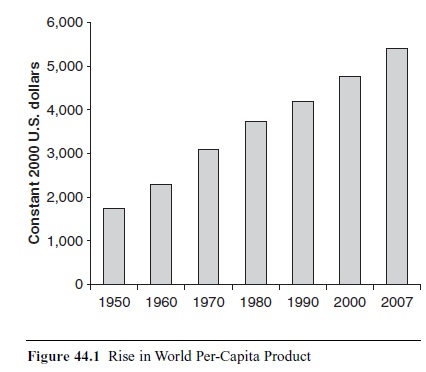
Figure 44.1 Rise in World Per-Capita Product
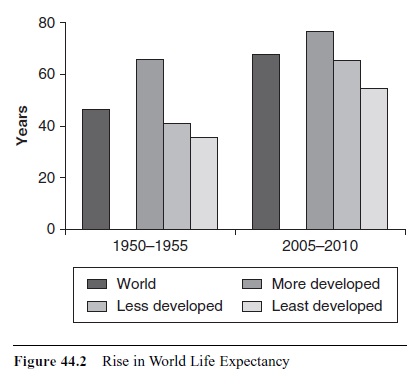 Figure 44.2 Rise in World Life Expectancy
Figure 44.2 Rise in World Life Expectancy
- Marked reductions in mortality have been recorded, which raised average world life expectancy by two decades (see Figure 44.2).
- The reduction in mortality was accompanied, but not simultaneously, by a decline in fertility, with a fall in crude birthrates from a figure generally over 40 per 1,000 to well below 15 in some countries (see Figure 44.3).
- School enrollment ratios increased from low and sometime negligible figures to ratios that included most if not all children, with a similar extension of education to previously ignored groups of youth and adults. The improvement in literacy is particularly notable in developing countries, where education for boys is nearly universal. The situation with regard to girls is less good and requires more attention (see Figure 44.4).
- Large changes in labor force characteristics can also be noted in response to changes in the age distribution of the population, in propensities of women to enter and exit the labor force, and, most important, to investments in human capital (see Figure 44.5).
Remarkable improvements in health status have taken place everywhere in response to new medicines, improved diagnoses, and greater access to health services. In turn, a better educated and more mobile population enjoying a longer and healthier life has provided the basis for continued gains in productivity permitted by a better fed, better educated, healthier, and more migratory labor force.
And it should not be forgotten that hand in hand with improvements in direct measures of well-being have come continuing advances in technology—especially in telecommunications and travel, in the biological and material sciences, and in information and computer technology. These improvements not only have intensified economic interdependence among countries but have also had a profound effect in each nation’s cultural sphere as people have become increasingly aware of events, lifestyles, and ideas in the rest of the world. Continuing advances in technology promise further increases in productivity and standards of living to the entire world’s population.
Given this experience, there can be no doubt but that the present era is one of great human advance that has been sustained—despite a number of persistent difficulties and setbacks of high cost—for more than a half century.
World Economic Performance in the Postwar Era
Among the most important factors affecting the life of each person on the planet is the performance of the world economy as it is reflected in the pace, character, and distribution of economic growth among its many countries. A high rate of economic growth is seen as a primary determinant of a country’s ability to raise the level of living of its inhabitants; provide them with more meaningful kinds of employment, better educational opportunities, and improved health status; and maintain and enhance the physical environment in which they live. At the same time, rapid economic growth necessarily involves a large-scale mobilization of resources and extensive structural change, processes that often involve social disruptions and unsustainable elements such as ecological damage, the accumulation of wastes and pollutants, and the profligate use of energy, forests, water, and other natural resources. Moreover, economic advance always challenges existing political and social arrangements, often with the loss of cherished traditions and ways of life that people value more than higher incomes and wider economic opportunities.
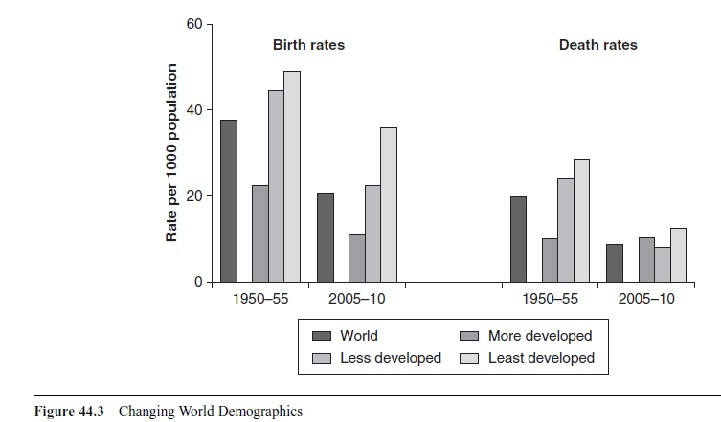 Figure 44.3 Changing World Demographics
Figure 44.3 Changing World Demographics
For this reason, the benefits world growth brings must always be matched against its noneconomic costs. Nonetheless, it remains true that without a steady and continuing rise in income per person, the capacity to sustain, much less improve, living conditions for the vast majority of the world’s population who continue to live in dire want is impossible. Therefore, any assessment of the long-term performance of the world economy must also include the contribution growth has made to raising levels of living across the entire globe, especially in the world’s poorest countries where abject poverty remains endemic and an unacceptable blight on the human condition.7
Six Decades of Rising World Output
Without question, an unprecedented period of global economic expansion and diversification began after World War II. Output in all world regions has risen markedly and for the most part continuously since 1950, and the rate of increase recorded—an average rise of about 3%% each year—compares favorably with any past era in human history (see Table 44.1). World population rose in numbers from 2% billion in 1950 to more than 6% billion today, an annual increase of 1%%, about double the rate of increase from 1900 to 1950 and triple the rate of the century before. The world labor force rose even faster than population as changing social norms and greater control over fertility increased women’s participation in the workforce.
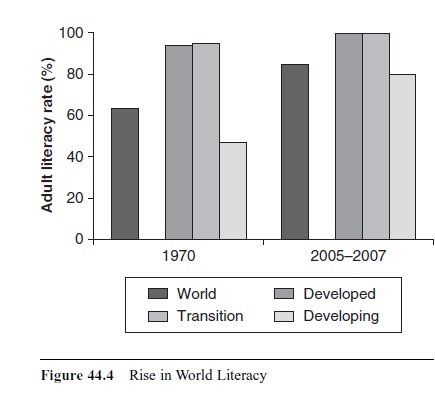 Figure 44.4 Rise in World Literacy
Figure 44.4 Rise in World Literacy
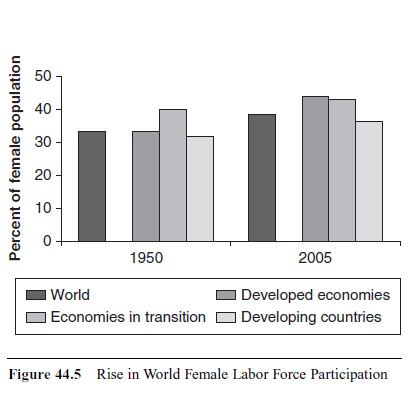 Figure 44.5 Rise in World Female Labor Force Participation
Figure 44.5 Rise in World Female Labor Force Participation
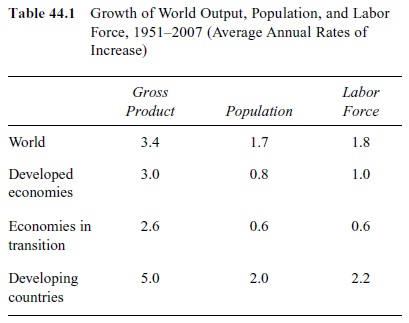 Table 44.1 Growth of World Output, Population, and Labor Force, 1951-2007 (Average Annual Rates of Increase)
Table 44.1 Growth of World Output, Population, and Labor Force, 1951-2007 (Average Annual Rates of Increase)
With the more rapid increase in production over population have come significant improvements in levels of living for most of the world’s population as well as an increased capacity to address environmental, health, and social problems. Spurred on by rapid growth, rising international trade, and rapid advances in technology, the structure of the world economy has also been transformed radically as essentially rural and traditional economies became urban and more commercially oriented producers of goods and services for domestic and foreign markets. With this transformation have come better employment opportunities, safer places of work, and less time spent in the workplace.
However, the rise in world output and its distribution among the world’s nations has not been uniform over time or over the globe. In the industrialized and service-oriented economies of Europe, North America, Japan, and Oceania, which taken together account for the preponderant proportion of organized global economic activity, this long-term expansion has been characterized by widespread prosperity and a process of convergence in which the initial gap in productivity among these countries has been progressively reduced over time. Although these countries enjoyed a long-term and broad-based expansion, growth in the more economically advanced countries was nonetheless interrupted several times by deep recessions, and the functioning of their economies over time reflected increasingly high unemployment, growing imbalances, and difficult recoveries. More significant for their future, as discussed below, the average pace of economic growth in many of these countries tended to slow down noticeably over time, and widening disparities in income distributions have come to characterize many of them in recent decades (see Table 44.2).
At the end of World War II, the countries of Eastern Europe and the former Soviet Union faced a heavy burden of reconstruction and undertook far-reaching changes in the organization of their production and trade. Seen in longer term perspective, the tempo of production in East Europe and the successor states of the former USSR, which had been rapid for three decades under central planning, slowed markedly during the 1980s, and the absolute level of real output produced in these countries fell precipitously in the 1990s, when the economic model on which their production had been based proved unable to sustain their level of living. These countries are now undergoing a remarkable political and economic transition from state socialist and centrally planned economies to a more market-oriented and open economic system with greater integration into the world economy. Growth in many transition countries in the 2000s has been bolstered by high commodity prices and is now higher than rates recorded in earlier decades. Nevertheless, their share in world production is lower today that it was a half-century ago, and the distribution of income within these countries has become more skewed.
The past six decades have also witnessed great progress in the economically developing countries of Africa, Asia, and Latin America and the Caribbean, but this advance has been combined with setbacks in some countries and regions: most notably, lagging growth in many of the world’s poorest countries. Generally rapid and rising economic growth over the entire period has been recorded in South and Southeast Asia. This growth has been linked to international specialization and the advantages offered by cooperation within the established frameworks for open multilateral trade. In China, an extraordinary growth momentum has developed over the past three decades, with sustained increases in production on the order of 8% to 10% a year. In Latin America and the Caribbean, on the other hand, early decades of expansion have been replaced by decades of stagnation and slower growth performance as this region responded with great difficulty to external shocks that arose during the 1970s and 1980s. Similarly, in Africa and Western Asia, an initial period of good performance has been followed by an extended period of weak and faltering growth, which has recently strengthened in the global economic upturn of the early years of this century but remains fragile and dependent on continuing high commodity prices.
 Table 44.2 Share of World Output, Population, and Labor Force, 1950 and 2007 (Percentage Share in Corresponding World Total)
Table 44.2 Share of World Output, Population, and Labor Force, 1950 and 2007 (Percentage Share in Corresponding World Total)
In the opening years of the new century, a more rapid pace of economic growth returned to all developing country regions. To sustain this growth, many of these countries must address the legacies of persistent internal and external imbalances and high foreign debts inherited from the past quarter century. The difficulties of this adjustment are compounded by the challenge presented by the very process of development and the changes that must be introduced to adjust and adapt to pressures of globalization and the tendency toward growing disparities within their national economies. This adjustment has been made more difficult by the 2008-2009 downturn in the global economy but is essential for creating conditions for long-term world growth.
A Buoyant but at Times Difficult International Economy
The global economic expansion of the past six decades benefited from strong international institutions and a buoyant international economy, generally supportive national economic policies that recognized the importance of the external sector, and an unprecedented pace of technological advance that encouraged a wider division of labor among the world’s economies.
The unstable international economy of the interwar years led to the recognition that the foreign trade sector would be critical for all countries in the postwar era. For the first time, the Bretton Woods agreement of 1944 established a formal international system to govern monetary and trading relations among independent nation-states. When designing the system, the objective was to promote an open multilateral system of international trade based on fixed exchange values, a steady flow of international liquidity, mechanisms to support the balance-of-payments adjustment process, and rules governing the conduct of international trade. To this end, the Bretton Woods system called for the gradual removal of trade controls and impediments, as well as the attainment of sustained rates of domestic economic growth by raising the productivity of the national workforce of each country through participation in a wider international division of labor.
The international arrangements and more outward-oriented policies of the postwar era brought about an expanding flow of world trade that stands in marked contrast to the sharp contraction recorded during the prewar years. An extraordinary expansion of international commodity trade and a great increase in cross-border travel, communications, and exchange of other services began after 1950 and have continued to the present. There were, of course, setbacks, and not all countries and regions participated in the growing international economy. But except for a turbulent period in the mid-1970s and the early 1980s, the reverses were few and of short duration, and while the momentum of trade lessened somewhat after several decades, the strong upward trend in international trade has been a major factor promoting and sustaining world economic growth.
In terms of the tempo of the expansion, the increase in world trade has been remarkable. On average, world trade in goods and services has risen at a rate of 6% each year since 1950, much more rapidly than the increase in world output and much faster than in any previous historical period of similar length (see Figure 44.6). In the decades following 1950, the volume of world trade, measured in constant dollar prices, increased by a factor of almost 35, whereas the volume of world output rose by a factor of only 8lX. With the much faster rise in world trade over domestic product has come a much more closely integrated world economy, with tighter and wider interdependencies among its many countries and a growing awareness that the world is becoming globalized not only in production and exchange but in culture and social development.
Although widespread, the growth of the international economy has not been even over the world. Regions of the world that have participated actively in international commerce, such as the more economically advanced countries of Europe, North America, Japan, and Oceania and many developing countries in Asia, have experienced extraordinary increases in their trade over a long period of time. Countries in other world regions that chose not to fully participate in the international economy have found that the increase in their trade has been halting at times and characterized by turbulence and great instability. In the case of developing countries, the pace of trade expansion has been on the order of one and one half to two times as fast in Asia than in other areas of the world. Given these disparate rates of expansion, the developing countries as a whole, which accounted for approximately one quarter of the value of world trade in 1960, increased their share to more than one third a half-century later (see Figure 44.7).
Although rapid, the growth of the international economy has not been steady over time. Indeed, despite its overall vigor, at times it has been halting and characterized by turbulence and great instability. At the international level, following several decades of strong increases in world trade, a weakening of the international monetary and trading system occurred in the late 1960s and 1970s, reflected in volatile and misaligned exchange rates, fluctuating commodity prices, difficulties in balance-of-payments adjustment, and accumulating external and internal imbalances, especially growing external debts of developing countries. These problems have periodically caused interruptions and instabilities in the upward trend in world trade that have continued to the present (see Figure 44.8).
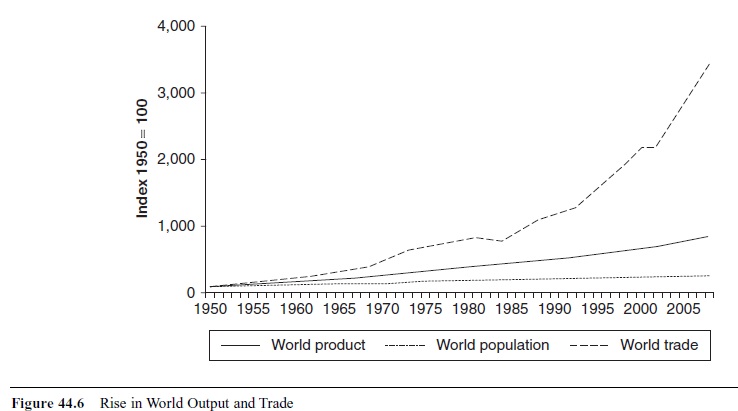 Figure 44.6 Rise in World Output and Trade
Figure 44.6 Rise in World Output and Trade
The pressures on the original Bretton Woods system during the late 1960s and early 1970s were particularly great. Toward the end of the 1960s, accelerating inflation, a widening external deficit, and an expanding pool of dollars accumulating as reserves and in banks outside the country caused the United States to terminate the convertibility of the dollar into gold in 1971. The upswing in world production and trade from mid-1971 into 1973 was one of the strongest on record, but it was associated with increasing instability in international commodity markets and growing pressures on domestic productive capacity. Inflation in the international economy accelerated in response to strong demand pressures from rapid world growth at a time of supply losses due to poor harvests. In 1973, the stability of the world economy began to erode further when the U.S. dollar came under speculative pressures, and the worldwide system of fixed exchange rates established at Bretton Woods came to an end when a floating currency regime was introduced. Adding to the problems, later that year, in the unsettled environment, the dollar price index for commodities entering world trade rose greatly, with the Organization of Petroleum Exporting Countries increasing crude petroleum prices fourfold within a year. As a consequence, the environment for trade and world growth became much more adverse, and twice a sharp decline occurred in the real volume of international trade, once in the mid-1970s and again in the early 1980s.
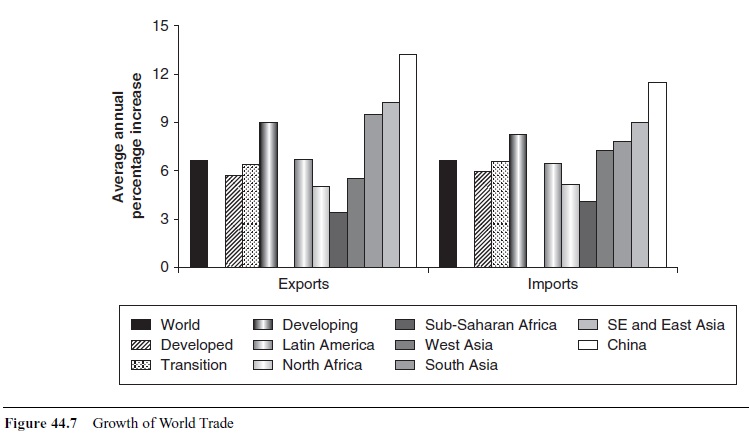 Figure 44.7 Growth of World Trade
Figure 44.7 Growth of World Trade
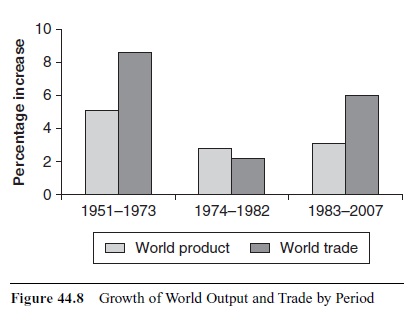 Figure 44.8 Growth of World Output and Trade by Period
Figure 44.8 Growth of World Output and Trade by Period
In retrospect, a remarkable era of world economic growth came to an end in 1973 as the tempo of global production and trade thereafter slowed noticeably and exhibited wider fluctuations and greater disparities in national economic performance. For the first time in the postwar period, the trend rate of world trade growth fell below the pace of world output as the world experienced its first major downturn since the years of global recovery and reconstruction directly after the war. In the wake of the collapse of the Bretton Woods system, wide deficits and surpluses came to describe the balance of payments of different groups of countries. The instabilities of the first half of the 1970s not only ushered in the first major recession of the postwar period but fundamentally changed the international price relationships and set of currency relationships on which the previous pattern of world growth and trade had been based. Throughout the 1970s and into the 1980s, higher commodity prices not only fueled inflationary pressures but also changed the basis for industrial costs that required a significant adjustment to domestic patterns of economic activity and resource use. Similarly, changes in exchange rates magnified the need for new and significantly different economic relationships among countries as their former focus of international specialization became obsolete in a markedly different international economic environment. While long-term world growth recovered somewhat after the early 1980s, it has not reattained the momentum recorded from the 1950s to the early 1970s.
All major groups of countries and all geographic areas have benefited from a dynamic international economy of the past six decades. It has at once boosted their possibilities for growth through greater specialization, leading to higher productivity and a wider variety of goods and services, leading to higher levels of living. But at the same time, increased participation in the world economy has brought economic and financial difficulties of sizable proportions to each and every country. With greater international exchange have come intensified pressures for adjustment and adaptation to rapidly changing patterns of international commerce, and increasingly, integrated world product, factor, and financial markets have increased each country’s vulnerability to events and conditions occurring in the rest of the world. While difficult and presenting major challenges to all countries, there can be no doubt that the world has benefited greatly from the more stable and prosperous international economy of the past half-century than the hostile and protectionist international economic environment that described previous epochs in world economic history.
Acceleration Followed by Slowdown in World Productivity Growth
The efficiency with which the world uses the capital, labor, and natural resources at its disposal is the most important determinant of the level of living of its inhabitants and their possibilities for addressing the economic problems humankind faces. For this reason, the increase in the productivity of each person in the workplace is a key consideration when assessing how successful the production process has been in improving the lives of people because the growth of consumption per capita is related to the increase in output per worker. Because the number of people in the labor force tends to move with the number of people in the population, labor productivity growth measured as output per worker drives the rise in real incomes per person over time.10
Seen in long-term perspective, the rate of world productivity increase has been exceptionally high during the last half of the twentieth century into the twenty-first. World output per person in the labor force has been estimated by Angus Maddison (2001) to have risen at most 1% a year on average in the decades immediately prior to 1950 and an even slower pace in earlier centuries. In contrast, the pace of world productivity advance accelerated to an average annual increase of 1% a year in the decades after 1950, a historically unprecedented rate of growth for such a long period and one that would double average levels of income in about 40 years (see Figure 44.9).
Reflecting this fast pace of change, world output per economically active person, measured in 1990 prices and exchange rates, rose from an average of $3,760 in 1950 to more than $11,400 in 2007. International trade and rapid advances in technology promoted this rise in overall productivity through a wider division of labor at the world level and a wider range of goods and services in the domestic marketplace. As a consequence, as world levels of living rose, domestic economies were completely transformed in terms of their productive structures as increases in output per person in agriculture and manufacturing not only far exceeded those in services but rose faster than the growth of demand for these products. What was mainly an agrarian and industrial world economy in 1950 became a world economy increasingly oriented toward the delivery of services.
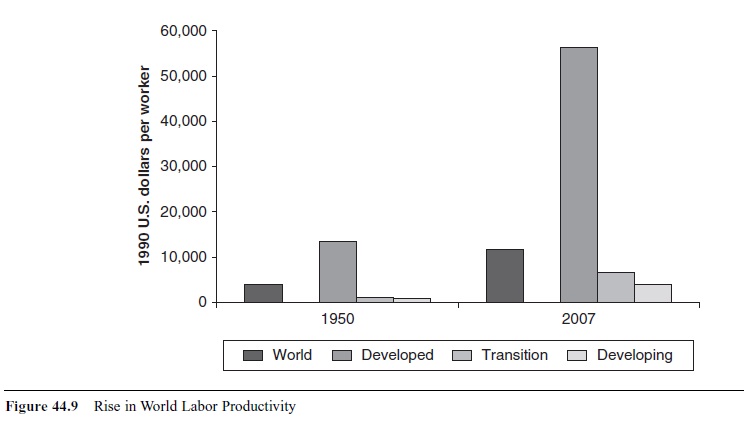 Figure 44.9 Rise in World Labor Productivity
Figure 44.9 Rise in World Labor Productivity
However, it is also fair to say that, although unprecedented, in some respects, long-term world productivity performance has been characterized by deficiencies that became increasingly evident over time (see Figure 44.10). The broadening increases in productivity that did emerge in the early postwar decades, for example, should have been sustained and strengthened in later decades as a gradual diffusion of technology to all countries and a wider scope for introduction of new methods of production in low-income countries supported strong, steady, and spreading rates of economic growth. Lower transport costs, falling trade barriers, and what would appear to be cascading economies of scale spreading through the world production system should have supported not only a widening division of world production and a far greater variety of goods and services available at the national level but also an accelerating expansion of output as average costs declined continually and demand climbed steadily in response to higher real incomes. In the same manner, increased attention to investment in human capital in all countries, especially in low-income countries, should lead to the entrance of a growing number of workers with enhanced educational backgrounds and training, thereby raising the knowledge and skills of the labor force. Finally, rising life expectancy and an improvement in a wide range of social conditions in almost all countries should also provide a basis for a rapid, equitable, and steady expansion in world economic activity.
Contrary to expectations, however, accelerating technological advance, a widening network of international trade and investment, and rising literacy and improving social conditions in all groups of countries did not raise—indeed, did not even prevent a persistent fall in—the long-term rate of world economic growth.
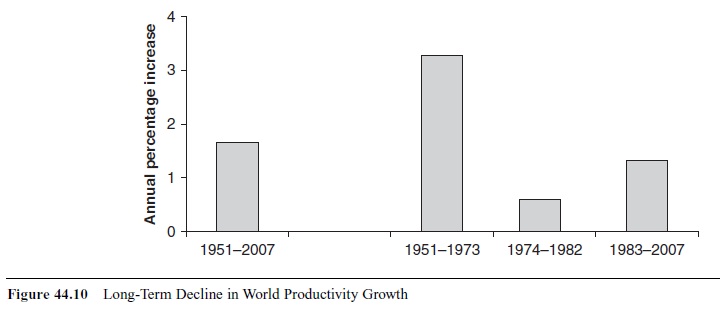 Figure 44.10 Long-Term Decline in World Productivity Growth
Figure 44.10 Long-Term Decline in World Productivity Growth
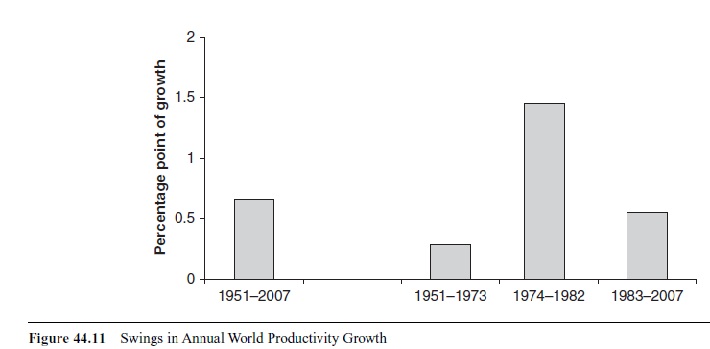 Figure 44.11 Swings in Annual World Productivity Growth
Figure 44.11 Swings in Annual World Productivity Growth
While the early period of the 1950s, 1960s, and into the 1970s were years of high, stable, and balanced worldwide growth, beginning in the early 1970s, the pace of world productivity advance showed a persistent tendency to slow down and exhibit greater instability and disparities. For much of the earlier period, the international monetary system provided the needed international liquidity, and the international adjustment mechanism allowed for the effective elimination of balance-of-payments disequilibria without resorting to overly restrictive domestic policies and the introduction of barriers to trade at the national level. Investment effort—the share of produced resources devoted to physical capital formation— rose, and investment efficiency—the lowest number of dollars of investment necessary to raise labor productivity by a dollar—remained high. As a result, from the early 1950s into the early 1970s, the rate of world productivity growth was rapid, increasing at an average of more than 3.3% a year, truly an outstanding rate of increase in productivity for such a long period of time (see Figure 44.11).
However, the high and steady expansion of the early postwar years was followed by slower and more unstable growth in later decades. As noted earlier, at the national level, widening imbalances in the external accounts came to be recorded in many countries. Inflationary pressures also increased over time, with the rise in U.S. dollar-weighted prices accelerating steadily from less than 3% a year in the 1960s to more than 14% a year by the end of the 1970s. Marked accelerations and decelerations in economic growth were recorded as short-term trends in industrial production, and wide swings in aggregate demand led to steep recessions in the mid-1970s and early 1980s. In the unstable economic environment of these years, rising unemployment and slower trend world productivity growth could also be noticed as the decade of the 1970s ended and that of the 1980s began (see Figure 44.12).
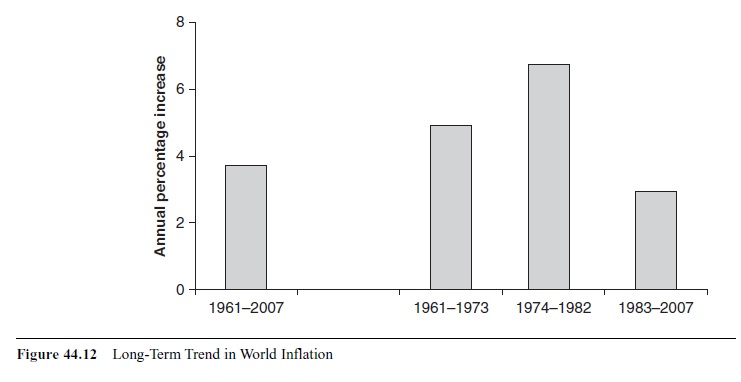 Figure 44.12 Long-Term Trend in World Inflation
Figure 44.12 Long-Term Trend in World Inflation
Although world productivity growth revived somewhat after the early 1980s, and progress was made in reducing inflation from the double-digit rates of the late 1970s, the pace of world productivity growth the past quarter century is half the rate recorded the first quarter century after World War II. Similarly, unemployment rates are significantly higher than in the past, and while the rate of world inflation has fallen to a point today where deflation has emerged as a concern, seen in longer term perspective, U.S. dollar prices are much more volatile than in the past. Wide imbalances have arisen in the external accounts of many countries, and exchange rate fluctuations remain a concern for many countries. Even given these trends, it cannot be denied that the past 25 years have been remarkable for the world economy.
Growing Disparities in Productivity and Levels of Living
Given the rapid, if slowing, pace of world growth over the longer term, there are reasons to believe that the increase in world output and overall improvement in living standards should be shared in an equitable manner among richer and poor countries. In the standard paradigm of long-term economic growth, the expected pattern of world development is a path of convergence in productivity among countries as the rate of increase of countries at lower levels of productivity exceeds the rate of increase of countries at higher levels of productivity.
This tendency toward convergence derives from an assumption of diminishing returns to capital, where levels of output produced per person in countries with more capital per worker tend to have lower rates of return on investment and lesser increments in output produced per worker than countries with less capital and lower levels of productivity. In this view, as capital accumulation takes place in high-income countries, the productivity of capital falls, and the incentive to save is reduced; conversely, the higher productivity of capital in low-income countries encourages saving and capital accumulation, thereby generating a more rapid pace of economic growth from any given share of investment in gross domestic product (GDP). As a result, poorer countries, with less capital per worker and higher rates of saving, should grow faster than richer countries as they reap higher returns from investment in plant, equipment, and other physical assets.
For this reason, it was expected that the wide and growing disparities in income and wealth among different regions of the world that existed in 1950 should have progressively lessened as economic growth spread across the globe. It is possible that some widening of income gaps between rich and poor could occur if some countries take off into modernity before others. However, as more and more countries begin the process of modern economic development, these gaps should tend to close as countries at low levels of income per capita grow faster than countries at high levels of per capita income. Moreover, it was thought that countries at lower levels of technological development could draw on the advances already in place elsewhere to accelerate their growth. Over a period as long as half a century, a clear process of convergence in average levels of income among the world’s countries should have begun.
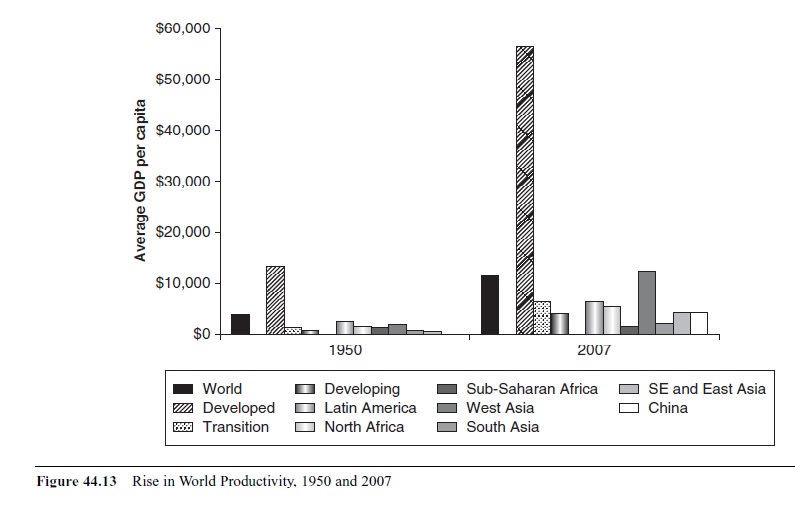 Figure 44.13 Rise in World Productivity, 1950 and 2007
Figure 44.13 Rise in World Productivity, 1950 and 2007
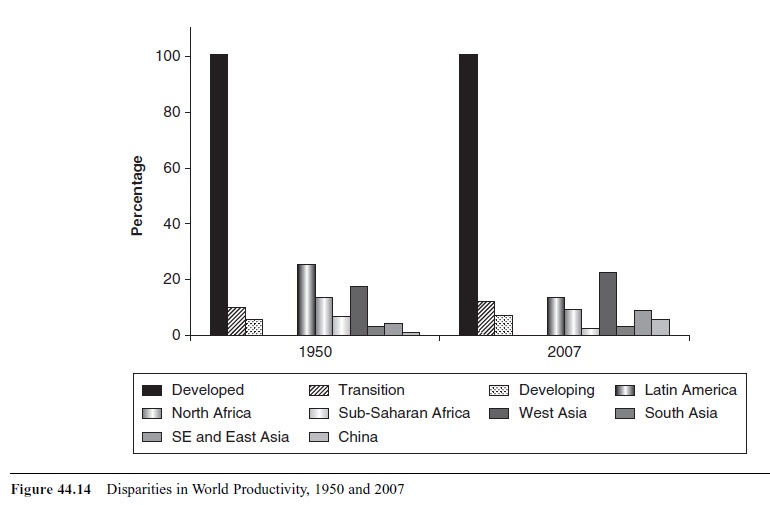 Figure 44.14 Disparities in World Productivity, 1950 and 2007
Figure 44.14 Disparities in World Productivity, 1950 and 2007
In terms of productivity, when classified broadly by level of development, output produced per worker in 1950 in the more economically advanced areas was far greater than in other world regions (see Figure 44.13). Measured in 1990 prices and exchange rates, it is estimated that average GDP per economically active person was $13,525 in 1950, or more than 18 times higher than the level of output per worker produced on average in developing countries ($720) and more than 10 times higher than that produced in the countries now classified as economies in transition ($1,260). Within these major economic regions, productivity levels differed among the countries and subregions, especially in the case of the developing countries, where the range in average output per worker in 1950 was as high as $3,400 in Latin America and the Caribbean and as low as $150 in China.
More than half a century later, productivity levels had risen greatly in all major groups of countries, and some narrowing of the income gap among the broad groups of countries can be seen. By 2007, productivity in the developed economies had risen to an average of more than $56,000 per worker, or a factor of more than 4. Taken as a group, the relative rise from the levels of 1950 was even greater in the case of the developing countries and the economies in transition, as the average level of output produced per worker in these two major economic regions rose by a factor of 5 (see Figure 44.14). In the case of all developing countries taken together, output per worker had increased to $3,700, and the productivity gap with respect to the developed economies had been reduced from more than 18 to 1 in 1950 to 15 to 1 in 2007; in the case of the economies in transition, output per worker rose to $6,430, and the reduction in the productivity gap was from more than 10 to 1 down to less than 9 to 1. Seen in terms of broad changes across the world, the expansion of the past half-century set in motion a slow process of income convergence across the globe, but great differences in average levels of incomes and productivity between rich and poor countries remained.
Moreover, while the pattern of world growth has closed somewhat the gap between broad groups of countries, growth has not been evenly spread within the group of developing countries. Consequently, the dramatic differences in levels of average productivity and incomes that existed in 1950 have become wider over time. In general, the populous developing countries in Asia have begun to close the income gap, while those in relatively less populous regions of Latin American and the Caribbean and in Africa have lagged in the process of world development. Indeed, over the course of the past half-century, disparities in levels of living between the least developed countries of sub-Saharan Africa and all other countries—developed, in transition, and developing—have become increasingly stark. For these countries, the world expansion of the past half-century has not operated in a way that counters the wide differences in levels of living that existed in 1950.
Record of World Economic Performance and Prospects for the Future
The record of world economic performance in the postwar era is the greatest in human history. For practical purposes, during this period, all of humankind was mobilized for the cause of economic advance and social betterment. Those parts of the world that had in the previous half-century suffered from a Great Depression and had mobilized twice for a total war recovered to enjoy a high and rising standard of living and a prolonged period of relative peace. In those parts of the world where economic advance before 1950 was limited or where it had never taken root, marked progress was made in lifting incomes and improving the lives of literally billions of people who were previously engaged in a daily life-and-death struggle for survival. These years saw world food production per capita rise steadily, industrialization spread across the globe, commercial services come to dominate production, and the services of government become essential to society’s welfare, a complex web of intergovernmental agencies watch over the international economy, and international trade, travel, and communications link the world together. The world economy today is entirely different from that of the past.
Of equal significance to the successes of world development are the legacies of failure and the demands of continued progress. The twentieth century leaves to the twenty-first its failure to accelerate the development of the world’s poorest countries so as to ensure balanced world development across all countries and all people. Even where it has taken root, the gift of development has brought with it never-ending adjustment costs attendant to advancing technology and the spread of innovations and new ideas across the world. As Joseph Schumpeter (1950) noted, the costs of what he called “creative destruction”— those involved in introducing new products and structures of production, removing obsolete and unproductive activities, and redeploying their associated resources to sectors of rising productivity—are heavy and increasingly unwelcome. The costs of economic advance are short term, sharp, and concentrated, while the gains are long term, gradual, and dispersed. Understandably, with the comforts of development has come hostility to continued advance on the part of those who now enjoy living standards never before achieved by humankind.
But the vast mass of humanity has yet to benefit from the fruits of the unparalleled economic advance of the past half-century. Despite its costs in terms of the disruption to present patterns of production and trade, a continued and increasingly wider rise in global output is essential to lifting the living standards of the world’s poor. This is not simply a moral imperative. If world economic growth is not sustained in a way that spreads economic progress across the planet, conflict among the world’s people is inevitable. Equally, challenges of aging populations in rich countries amid continued rapid population increase and high fertility in many poor countries represent major concerns about the future that can be overcome only with the additional resources generated by widespread economic growth. Finally, as the process of world development proceeds, humankind must find a better way to manage the global commons and deal with the most dangerous trends of climate change, species extinction, and unsustainable land and resource use. Making world growth compatible with global environmental sustainability is the greatest challenge of the twenty-first century.
See also:
Bibliography:
- Adelman, I. (1997). The genesis of the current global economic system (Working paper). Berkeley: University of California. Retrieved February 28, 2008, from http://are.berkeley .edu/~adelman/KEYNOTE.DOC
- Easterlin, R. A. (1998). Growth triumphant: The twenty-first century in historical perspective. Ann Arbor: University of Michigan Press.
- Easterly, W. (2001). The elusive quest for growth: Economists’ adventures and misadventures in the tropics. Cambridge: MIT Press.
- Helpman, E. (2004). The mystery of economic growth. Cambridge, MA: Belknap Press of Harvard University Press.
- Henderson, D. (2001). Anti-liberalism 2000: The rise of new millennium collectivism. London: Institute for Economic Affairs.
- Johnson, H. G. (1965). The world economy at the crossroads: A survey of current problems of money, trade and development. Oxford, UK: Clarendon.
- Kindleberger, C. P. (1973). The world in depression, 1929-1939. Berkeley: University of California Press.
- Maddison, A. (2001). The world economy: A millennium perspective. Paris: Organization for Economic Co-operation and Development (OECD).
- Schumpeter, J. A. (1950). Capitalism, socialism and democracy (3rd ed.). New York: Harper & Row.
- Walker, D. O. (2008). Historical estimates of world economic activity, population and labor force, 1950-2007 (Data 2008/Version 1, Regent University Working Paper). Retrieved December 13, 2008, from http://thedougwalkertdj.blogspot .com/2008/12/documentation-for-historical-estimates.html
- Ward, M. (2004). Quantifying the world: UN ideas and statistics. Bloomington: Indiana University Press.
- Yeager, L. B. (1966). International monetary relations. New York: Harper & Row.
Free research papers are not written to satisfy your specific instructions. You can use our professional writing services to buy a custom research paper on any topic and get your high quality paper at affordable price.






